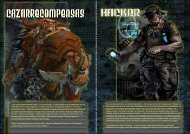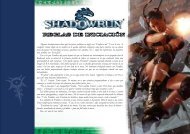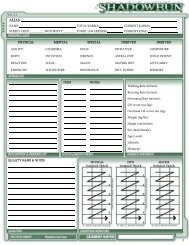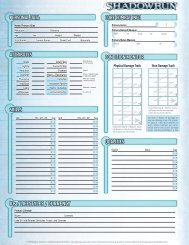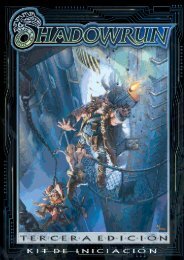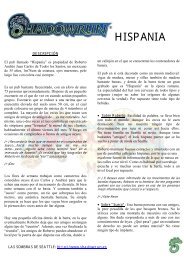Critters Sourcebook
Critters Sourcebook
Critters Sourcebook
You also want an ePaper? Increase the reach of your titles
YUMPU automatically turns print PDFs into web optimized ePapers that Google loves.
HOW TO USE THIS BOOK<br />
This book provides a comprehensive listing of creatures<br />
that appeared in previous Shadowrun products, including a<br />
brief description of each critter and its game statistics. In addition,<br />
this section covers the various rules needed to run critters<br />
in the game and gives a complete listing and explanation of all<br />
critter powers.<br />
<strong>Critters</strong> make an exciting addition to any campaign,<br />
whether serving as guard animals or appearing in random<br />
encounters throughout the urban or rural jungle. As a result of<br />
smuggling operations, the requirements of research facilities<br />
and experimentation (both legal and illegal), any critter can be<br />
found anywhere in the world. Having a wyrd mantis attack a<br />
team of runners on the streets of downtown Seattle might<br />
seem like a stretch, but it provides a perfectly plausible starting<br />
point for a shadowrun to disrupt a smuggling operation<br />
funded by a group of bug spirits experimenting with using the<br />
wyrd mantis as hosts.<br />
After the gamemaster chooses a critter to incorporate into<br />
his scenario or campaign, he should review its powers and outline<br />
how the creature might use them in various encounters.<br />
Keep in mind that, unlike characters, critters are born with their<br />
powers and use them in the most efficient and deadly fashion<br />
necessary, especially in a life-or-death struggle. Next, the<br />
gamemaster should craft a “plan of attack” against the creature,<br />
then review the combat rules for critters, making sure to<br />
apply the correct dice pools and karma (p. 6). After that—it’s<br />
time to let the chips fall where they may!<br />
DUAL BEINGS<br />
Most paranormal animals are able to manipulate and<br />
channel mana to fuel their various powers. Some creatures are<br />
so in tune with the flow of mana that the astral plane is open<br />
to them at all times; they coexist on the astral and physical<br />
planes. These critters have the ability to perceive and interact<br />
with the astral plane in the same way as characters using astral<br />
perception (see Astral Perception, p. 171 in SR3).<br />
Unlike magical characters, a dual being is always astrally<br />
aware. Such critters’ natural state is to be continually aware of<br />
both the physical and astral planes, so they cannot “turn off”<br />
their connection to the astral plane. This means that dual critters<br />
are able to act on either plane at any time. It also means<br />
they can be affected from both the physical and astral planes at<br />
any time. Because continuous astral perception is their normal<br />
state, dual beings do not suffer the +2 target modifier for nonmagical<br />
activity while using astral perception.<br />
Dual beings with magical skills are capable of astral projection.<br />
They can separate their astral bodies from their physical<br />
bodies, just as do full magicians. In this case, the being’s<br />
physical body sinks into a trance, but the free-roaming astral<br />
form can move about astral space. Their astral form’s Attributes<br />
are based on their Mental Attributes, in the same way as for<br />
astrally projecting characters.<br />
The various powers of dual beings can affect both physical<br />
and astral targets, much like spells (see Spell Targeting in SR3,<br />
p. 181). Only mana-based powers that affect the mind or spirit<br />
rather than the physical body can affect astral forms.<br />
SPIRITS<br />
Some paranormal beings live only on the astral plane and<br />
have no physical body. These beings are collectively known as<br />
spirits. Some spirits have the ability (if not the inclination) to<br />
form a material body for themselves in the physical world using<br />
the Materialization power (p. 12). A spirit in astral form acts<br />
and is treated much like an astrally projecting character. A spirit<br />
in material form is treated like a dual being (see above). For<br />
more information on spirits and their interaction with astral<br />
space, consult the Magic chapter, p. 188 of SR3.<br />
CRITTER COMBAT<br />
Characters are likely to encounter critters under hostile or<br />
dangerous circumstances, most often as watch animals for corporations.<br />
Whether critters are trained to attack or are simply<br />
defending their young or their territory, critters that attack a<br />
runner team use the standard combat rules presented on pp.<br />
100–129 of SR3, except as noted here.<br />
INITIATIVE<br />
Each critter description includes that creature’s Initiative<br />
dice. Determine Initiative dice for other critters according to the<br />
standard Initiative rules. To calculate a critter’s Initiative Score,<br />
roll the Initiative dice and add the result to the animal’s Reaction.<br />
Dual beings that engage in astral combat use their standard<br />
Initiative.<br />
Astrally projecting critters add 20 to their Initiative Score.<br />
ACTIONS<br />
Sentient creatures may perform the same actions as player<br />
characters, assuming they have the physical or paranormal<br />
means to do so. The gamemaster may need to make a judgment<br />
call on a critter’s abilities based on the published information<br />
about the critter.<br />
<strong>Critters</strong> make Damage Resistance Tests normally.<br />
CRITTER DICE POOLS<br />
<strong>Critters</strong> have dice pools the same as characters and nonplayer<br />
characters. However, creatures may apply only Karma<br />
Pool dice to tests made to use their powers.<br />
Combat Pool<br />
<strong>Critters</strong> engaged in combat may use Combat Pool dice. The<br />
Combat Pool is calculated the same as for a character: Quickness<br />
+ Intelligence + Willpower, divided by 2 (round down). For<br />
creatures with separate Intelligence Ratings, use the rating to<br />
the right of the slash (the one normally used for Perception) for<br />
this equation. All standard rules for Combat Pool use apply to<br />
critters (see Using Dice Pools, p. 104 in SR3). <strong>Critters</strong> can use a<br />
number of Combat Pool dice equal to their Reaction for attacks.<br />
Dual beings may use the Combat Pool for astral combat (in addition<br />
to their normal physical Attributes), unless they are astrally<br />
projecting (see Astral Combat Pool, below).<br />
Astral Combat Pool<br />
Astrally projecting critters may use an Astral Combat Pool.<br />
This pool functions according to the standard Astral Combat<br />
<strong>Critters</strong><br />
5



